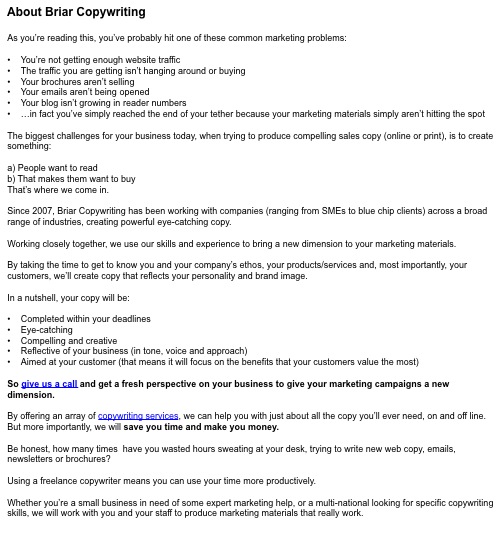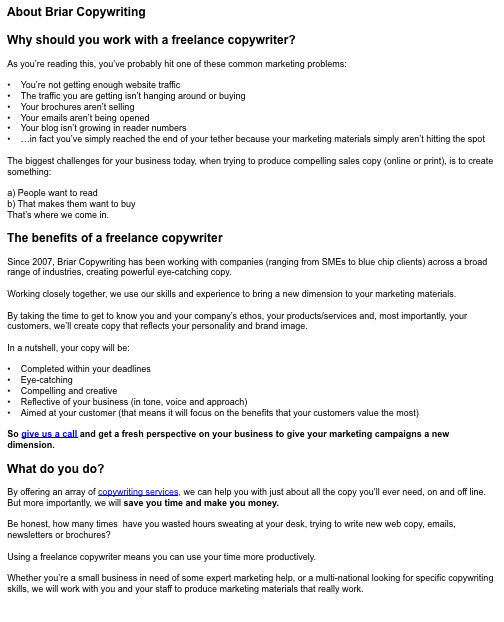Entries Tagged 'copywriting' ↓
December 17th, 2012 — Content writer, copywriter, copywriting, copywriting tips
Content rules the Internet and considering most of that is in the form of words, that’s a lot of reading.
You all know that reading from a screen is more difficult than reading from books or magazines. That’s not to say that your intellect suddenly falls several points when faced with a computer screen, but rather reading from a back-lit screen can be rather tiring on your eyes, which leads to less concentration.
That’s why its important to use sub headings – a feature used by every professional copywriter you’ll come across – because they make it easier for readers to read.
The best way to show you the effect sub headings have is through an actual illustration. Below is a sample of copy taken from by About Us page – first of all without any sub headings:

As you can see, even with the paragraphs intact the piece doesn’t really make you want to read. The text looks too dense and there is no direction as to what information the page contains.
Now let’s look at it again with the sub headings in place:

This time there is much more structure to the page. The sub headings act as signposts telling the reader what information the page contains making it easier for them to navigate to the section they want to read.
The aesthetics of sub headings
Aesthetically, the page looks more inviting with sub headings: a solid wall of text gives the impression that the subject matter is going to be difficult to read and boring, so it won’t encourage people to give up their valuable time to read it.
With sub headings the reader can break the page down:
- The sub headings act as rest points; the reader can break of at any time and not lose their place.
- They can glance down the page and pick out the information they need
- They give the impression of an ‘easy read’, which subconsciously suggests the information will be easy to grasp
So you see, just the simple inclusion of sub headings in your writing can boosts its readability.
Next time you’re writing website copy, brochures, blogs or articles, pay special attention to how you lay the information out. Use sub headings and short paragraphs to make it easy to follow and understand, that way you’ll boost your engagement with your readers.
November 21st, 2012 — copywriter, copywriting, Copywriting careers, copywriting tips
Invisible?
Why on earth would you want to make your copywriting invisible? After all, as a professional sales writer, you’ve spent hours crafting your carefully chosen words – you want people to love them.
The problem is, if that is your motivation (wanting people to love your words) your copy is unlikely to perform as it should.
Why?
OK, let’s look at it this way. If you are a fiction writer you want your readers to marvel at your prose. You would expect them to tell their friends about your amazing writing ability and story telling prowess. But that’s ok, because you’re writing fiction: a story that must entertain and enthral.
However, as a copywriter you are not writing for yourself. As a copywriter your role is to take on the voice of your client and to sell their products or services. Your writing becomes secondary to the sales message it conveys. In short, your writing shouldn’t distract your readers; they should just be able to concentrate on its message.
Copywriting aims
Your copy should convey meaning and connect with your readers. It has to satisfy their needs, influence, empathise with them and persuade them into taking a specific action.
There’s no room for your style or views in your copy; to be successful, you must immerse yourself in the style and views of your client – nothing else matters.
Yes, you must bring your persuasive writing skills to the table, but you must remember that you’re not writing for yourself. Keep that for the unfinished novel that’s sitting under your desk.
Copywriting qualities
To succeed in your copywriting career there are a few qualities that you must possess:
- Flexibility
- Ability to work to strict deadlines
- Excellent research skills
- Ability and willingness to learn from your mistakes
- Being able to think and write like someone else
- Being able to empathise with and understand different markets
But above all you must have a very thick skin. Sales writing is difficult and often clients won’t ‘get it’ straightaway, so you must be able to explain why you’ve taken the approach you have and give examples how it has worked for other clients.
So remember, your writing skills are secondary when it comes to writing great copy. The most important thing is the message; it must connect with your readers and get them to take an action.
If they are left admiring your writing instead, it’s time to switch careers!
November 19th, 2012 — copywriter, copywriting, copywriting tips, social media, social media marketing
Ask any professional copywriter and they’ll tell you it’s much harder to write short copy than long.
It’s much more difficult to get your message across when you only have a few characters to play with. That’s why social media copywriting is so tough and why so many people get it wrong.
How many times have you seen a random Tweet that’s full of abbreviations that makes no sense whatsoever? What about Facebook updates that ramble on and on?
In this post, I want to look at how to write effective social media updates that have meaning.
Twitter
Twitter is probably one of the hardest platforms to write for, purely because you only have 140 characters to play with.
As I mentioned above, the temptation is to squeeze as many abbreviations in as possible to ‘cheat’ the character limit.
But that usually ends up in a bizarre tweet that few people will bother looking at.
Writing short copy is difficult, but also a great way of honing your writing skills. After all, with only 140 characters to play with it’s essential that every word you use counts.
You can tighten your message by cutting out unnecessary adjectives (something that will also help your general sales writing) and by getting to the point straightaway.
Keep your tweet to one topic and remember to add a link if you want to direct people to an article or web page that backs up your tweet.
Keeping your updates short like this will also help your followers. If they like what you say and want to retweet it, by keeping your character count down they should be able to do so without having to go in and edit it down.
Facebook
Although Facebook gives you far more room for your updates, it is still good practice to keep them punchy and to the point.
If you post rambling updates no one is going to want to read them, so keep them short, relevant and interesting.
Also, if you want to raise your reach on Facebook ask for comments and reactions. The more reactions your post gets, the more newsworthy it becomes, which will increase its appearance in news feeds.
By adding video, polls and images you can increase your level of engagement, but what’s also important is to remember to post when your followers are likely to be online. The scheduling tool is perfect for this.
LinkedIn
LinkedIn is more about business and less about personal interaction. It is a platform from which you can show your expert status within your field. That means comments about needing a coffee, what you had for lunch etc., are not really going to be all that effective.
For LinkedIn look at posting news stories that are relevant to your industry and add your comments and opinions. This will encourage others to do the same and get a conversation started.
It’s also a great place to share news about your company, whether you’re hiring new people, starting a new exciting project or diversifying.
This social media platform opens up the opportunity for longer updates, but again they must be relevant and interesting.
As you can see, social media copywriting can be a complex animal, but it is also a great way to practice your short copy skills.
November 16th, 2012 — copywriter, copywriting, Copywriting careers, copywriting jobs, copywriting tips
That is something I am asked regularly by people who have been bitten by the writing bug and want to embark on a career as a professional copywriter.
There’s lots of advice out there and a few urban myths too, so here’s my story of how I got started.
You need an agency background
This is a common myth banded about.
Agency experience is useful and it may mean you have a few useful contacts tucked away up your sleeve, but it’s not a necessity.
Before starting my copywriting business, I had no previous experience in an agency or in a role as a copywriter. But what I did have was the ability to write clearly, powerfully and in a way that connected with my readers.
Going right back to the beginning, I started out life in the banking industry and spent a lot of time writing to customers on behalf of the branch manager (skill #1 learning to take on the voice of someone else).
After a career break to start my family, I began working for an international Leprosy charity. During that time I produced fundraising material for local campaigns (skill #2 writing persuasively with emotion to get people to take a specific action).
Then I decided to go back to school and embarked on a BA (Hons) degree in English Language and Literature with the Open University (skill #3 self-discipline and the ability to write with clarity).
After I graduated in 2007, a local businessman and friend asked for my help on a project he was working on. He knew I could write and needed some copy producing for one of his clients. I did the work, the project was a huge success and I was bitten by the copywriting bug.
Within a month, I’d set up my business, launched my first website and started learning about Internet marketing and social media.
As a result, about 70% of my new clients find me through my website with the remainder being word of mouth recommendations.
Networking and cold calling will get you clients
I’m sure for many, these options do bring in clients, but in the early days I did neither.
Cold calling is one of my pet hates; it really bugs me when people call me up trying to sell me stuff, so I refuse to do it to others.
As for networking, my initial decision to grow my business online via social media (‘virtual’ networking) came about because I am not a natural networker. Being of a shy disposition, walking into a room of strangers and striking up a conversation is my worst nightmare.
Of course, not everyone is like me and networking will get you in front of the people you need to speak with. So make sure you present yourself correctly. Don’t just way “hello, I’m a copywriter”, sell yourself by telling them “I help companies communicate more effectively with their customers through writing”.
Today, I do some networking, but I’ll never cold call.
You can only write for an industry you know about
Another myth.
Copywriting is about finding the right words to convey the right message to the right people.
Your client is the person who should know everything there is to know about their industry, not you.
As a copywriter, your role is to:
- Study the company and its brand
- Get a good knowledge of the service/product you’re writing about
- Understand their target customers
- Discover what it is that their customers want to know
- Identify the main benefits that will make the customers buy
The client is coming to you because you are an expert in your field not theirs.
You have to charge by the hour
No, no, no, no, no.
Clients aren’t paying for your time; they are paying for your experience and expertise.
You wouldn’t pay a plastic surgeon for the time it takes him to perform your tummy tuck – would you?
You are not just a writer – you are an expert in creating marketing communications that resonate with customers, compelling them to take a specific action.
Anyone can string a sentence together; not everyone can create copy that is powerful, persuasive and that gets results.
Useful links
That’s a whistle-stop look at how I got started as a copywriter, but there are numerous ways you can break into the industry.
A while ago, I was asked to participate in a couple of The Guardian Online’s forums about being a copywriter. The links to these are below so you can also read about how other copywriters started out.
Routes into copywriting
How to break into copywriting
October 31st, 2012 — copywriter, copywriting, copywriting tips, Copywriting tone
That might seem an odd question to be asking in a post on a copywriting blog, but it does make you think.
Many people believe that copywriting is all about being a red-hot grammarian, speller and punctuationalist (made-up word, but that’s OK because I’m a copywriter), but that’s not strictly true.
Granted, the ability to spell and use grammar and punctuation correctly helps, but it’s not the be all and end all.
You see copywriting is all about getting your sales message across to your audience clearly.
The most important elements in your copywriting
There are 3 vital elements to any copywriting assignment:
- Your audience
- The words you use
- The offer – your message has to be a goodie
When those are combined, that’s when your copy is cooking with gas.
Get any one of them wrong and you’re in trouble.
Your audience
If you don’t fully understand for whom you’re writing, how can you make sure you use the right language, tone and approach?
After all, a sales message to teenagers will need a different style and approach to something that’s going out to CEOs.
That’s why it’s vital you spend time getting to know your audience, understand what it is they want and then deliver it in their ‘language’.
Words
Using the right combination of words can lead to a powerful and effective message, but get them wrong and you’re left with a damp squib.
Think about what you’re trying to say and then make every word count. Keep your message active and punchy and make sure it really resonates with them.
Also, don’t be tempted to throw in an obscure word that you think makes you sound really intelligent because it won’t. It will just leave your audience bemused and they’ll wander off and find another message out there that tells them exactly what they want to hear.
The offer
The message is basically your offer.
You can hire the best copywriter in the universe, but if the offer isn’t what your audience wants, your campaign will fall flat on its face.
So think about your product or service and determine precisely what it is that will make your audience want to buy. Simply offering a free gift may not be enough to make them want it. The trick is to found the one major benefit will it bring that they’ll be desperate for – find that and you’ve got a campaign that’s ready to rock.
Arguably, you can add in a fourth element – timing.
When you launch your campaign will also have a bit impact on its take-up. If you’re looking for a seasonal promotion, it’s essential you plan well ahead – rushing something out at the eleventh hour is never going to work
All of these elements need to work together to make your campaign work. That’s why copywriting is such a collaborative process. Your client knows their company, products and services better than you, but you as the writer have more of an understanding of how the message should be conveyed.
So next time you embark on a marketing campaign think carefully about your audience, your message and how you’re going to communicate it to them.











